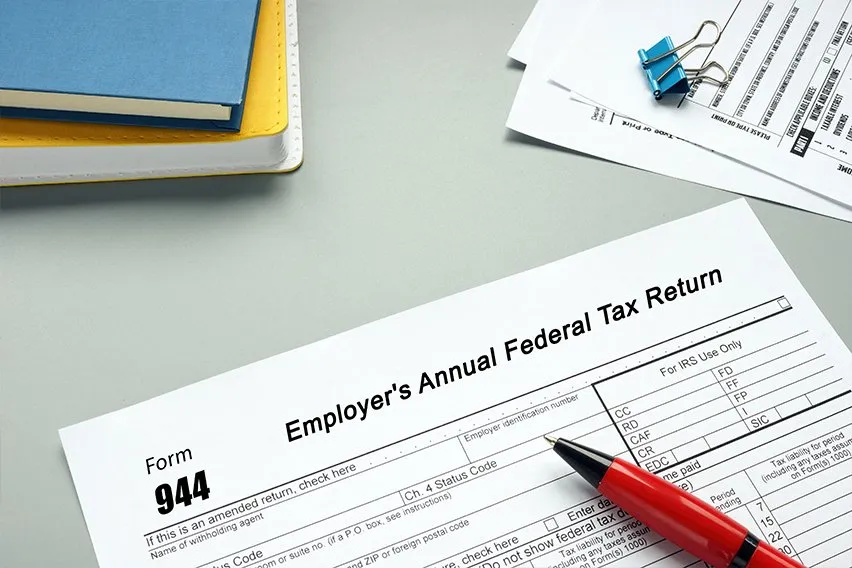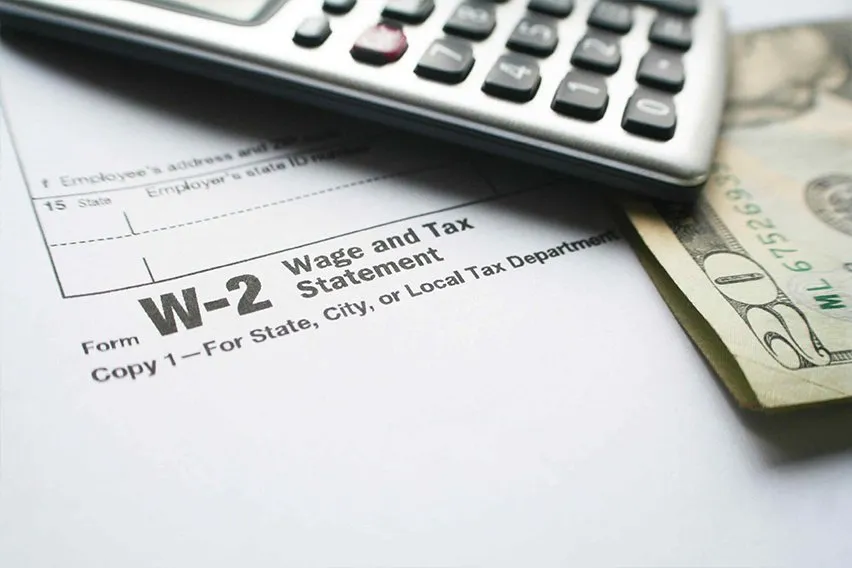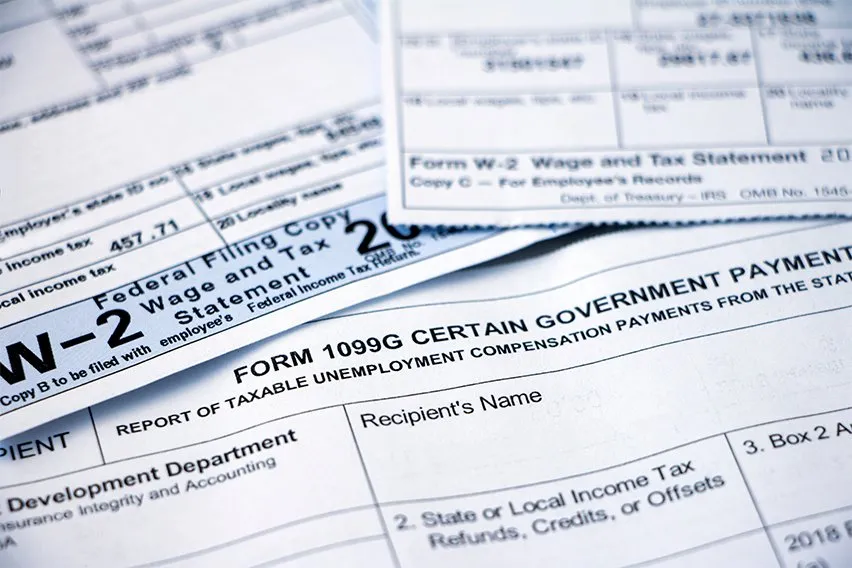What Is a 944 Form?

What is a 944 form and how do you know if you’re eligible? Let’s find out.
As a small business, part of your responsibility is to report income and payroll taxes withheld from employee wages. There is no shortage of tax forms to try and keep on top of (as well as running your business at the same time!)
Form 944 is the tax form that reports taxes withheld from an employee paycheck.
This article will help you understand what a 944 Form is, eligibility requirements, what it’s used for, and how you complete it.
Table of Contents
- What Is a Form 944?
- What Is the Difference Between a 941 and a 944 Form?
- What Information Does a 941 and 944 Form Request?
- How Do You Know if You’re Eligible to Use Form 944?
- Where Do You Find Form 944?
- How to Complete a 944 Form
- Step-By-Step Guide to Filing a Form 944
- Conclusion
What Is a Form 944?
Businesses typically use Form 941 to report on their employment tax liability. The 944 Form is for small businesses as they have fewer employees and lower tax obligations.
Form 944, or the Employer’s Annual Federal Tax Return, is an Internal Revenue Services (IRS) form that reports the taxes you’ve withheld from employee’s paychecks. The taxes this covers include federal income tax, social security tax, and Medicare Tax.
Employers should also use a 944 Form to calculate and report employer Social Security and Medicare tax contributions.

What Is the Difference Between a 941 and a 944 Form?
All employers need to report to the IRS the tax withheld from employees as well as their own tax liabilities.
Whether you do this through filing a 941 or a 944 Form will usually depend on the size of your business. If you run a small business with a lower tax liability, you may be eligible to file for IRS Form 944.
The main difference between the two forms? Filing frequency.
Small businesses submit a 941 form quarterly, whereas a 944 form is done annually. This helps to relieve some of the burdens on small businesses.
Other than the above, the two forms are largely the same in both design and content required.
What Information Does a 941 and 944 Form Request?
Some of the information that both forms require you to provide is:
- Employee information
- Wages paid out to employees
- If applicable, any tips employees earned
- Medicare tax
- Social Security tax withheld
- Federal income taxes withheld
- Total tax liability
How Do You Know if You’re Eligible to Use Form 944?
As a general rule, all businesses must file a 941 Form, also known as the Employer’s Quarterly Tax Return, unless told otherwise.
A 944 Form is the exception to this rule.
If your business has paid wages to a W-2 employee and has an employment tax liability of $1,000 or less, you are eligible to file a Form 944. Looking at it another way, you can file a 944 Form if you expect to pay $4,000 or less in employee wages for the year.
If this is the case, you can request permission from the IRS to use a 944 Form instead to allow you to file your tax returns yearly instead of quarterly.
A Few Important Considerations
Unfortunately, it’s not as simple as choosing which form you would like to complete.
Some things you need to be aware of are:
- You must have evidence of your eligibility from the IRS in writing to use the 944 Form.
- The two forms aren’t interchangeable. Once you have permission to file a 944 Form, you can’t then use a 941 Form instead without first contacting the IRS.
- The IRS may notify you to advise of your eligibility to submit a 944 Form. If not, you can contact them directly to ask for permission. This needs to be done within the first few months of the year.
- If you employ only household employees or agricultural employees, you will be ineligible to submit a 944 Form instead of a 941 Form.
- If you are a new employer, you may also be ineligible to submit a 944 Form. You can ask about this when you apply for your Employer Identification Number (EIN).
- The Form 944 has an annual liability and must be submitted by January 31 for the previous tax year. A Form 941 needs to be submitted on April 30, July 31, October 31, and January 31.
Where Do You Find Form 944?
You can find a 944 Form on the IRS website, along with other business tax forms.
How to Complete a 944 Form
You can choose to complete the form online, download it and complete it electronically, or print a hard copy from the website.
Once you have filled it in, you can then either submit it by e-filing it or by mail.
E-filing
The IRS encourages you to submit your form electronically if possible using its E-File System.
You can choose to submit the e-file form yourself, although you will need to use an IRS-approved software provider to do this.
Or, you can hire a tax professional to e-file on your behalf.
You can also check if the payroll or accounting software you use has the functionality to complete and file the 944 form.
By Mail
The IRS provides this list on its website.
Depending on where you are in the country, there are specific IRS branches that you should send your letter to.
Additionally, if you are mailing a return with or without payment, they suggest different addresses.
Step-By-Step Guide to Filing a Form 944
Now you know what it is and who is eligible for Form 944, here is a handy step-by-step guide to help you fill out the form.
The form is two pages and contains five parts, and we’ll cover how you can fill them all in.
Gather All Your Information Together
This part is where having good accounting software comes in handy.
Some software will have the utility to provide you with the exact figures you need.
If you need to gather the information together yourself, here’s what you will need to know.
You’ll need to collect all payroll taxes, FICA taxes (social security & Medicare), and federal income taxes withheld from employee wages.
You’ll also need to know exactly how much you paid your employees during the relevant tax year.
On page 1, you fill in basic information about your company, including:
- Employee Identification Number (EIN)
- Your name
- Your trade
- Your address
Part 1 (Wages and Taxes)
In part 1 of Form 944, the first two boxes you fill in are:
- the total wages you paid to your employees for the year
- the total federal income tax for the year that you withheld from these wages
Next, you need to let the IRS know if the wages paid are subject to Medicare or Social Security taxes. If so, you must complete the related sections.
In total, there are 12 lines to complete in part 1.
Part 2 (Business Deposits & Tax Liability For The Year)
The next section of the form relates to your business’s deposits throughout the year.
From here, you’ll have two choices:
- If your total taxes after adjustments and credits is below $2500, then you move on to the next part of the form.
- If the total is higher, then you’ll need to fill in your liabilities on a per month basis. You’ll then total these up at the bottom of part 2.
Part 3 (Business Closure)
Part 3 will ask if your business has closed, or if you’ve stopped paying wages. If neither is applicable, we keep moving.
The next stage asks if you would like to designate a third party that the IRS can speak to about your tax issues. This is appropriate if you have an accountant.
Feel free to check “NO.”

Part 4 (Permission to Speak With a Third-Party Designee)
This section relates to giving the IRS permission to speak with a third party, such as an employee, accountant, or tax preparer.
This person needs to be knowledgeable enough to answer any questions the IRS might have about the form.
Part 5 (Confirmation and Send It Off)
Part 5 asks that you fill out your information, confirming that it’s all above board.
Once it’s all signed off, you can send it off, keeping special attention on the date of fling.
Conclusion
Let’s quickly summarize what we covered.
All businesses must report on the income and payroll taxes withheld from employee wages. This is usually done via a Form 941.
Small businesses with an employment liability of $1,000 or less can use an IRS Form 944.
The main difference compared to a 941 form is that businesses submit it yearly as opposed to quarterly.
The Form 944 is a recognition by the IRS of the burdens already placed on small businesses and is an attempt to help ease this slightly. You can either fill in the form online and submit it by e-filing, or you can post a hard copy.
If you think you are eligible to submit a 944 Form instead of a 941 Form, you can contact the IRS directly and ask about this. The IRS may also contact you if they think you are eligible. If you’d like to have a look at the forms themselves, a copy is available to look over on the IRS website.
Hopefully, this article will help make things a bit clearer in understanding your tax filing obligations as a small business! If you have any more questions, please contact our experts and we’ll be happy to help.
For more helpful resources for your small business, check out our blog.
RELATED ARTICLES

 7 Best Sales Tax Software For 2025
7 Best Sales Tax Software For 2025 Does Overpaid Tax Get Refunded Automatically?
Does Overpaid Tax Get Refunded Automatically? Form W-2 Box 1: A Complete Guide
Form W-2 Box 1: A Complete Guide IRS Form 7200: A Detailed Explanation Guide
IRS Form 7200: A Detailed Explanation Guide What is the NOPAT Formula? – Net Operating Profit After Tax
What is the NOPAT Formula? – Net Operating Profit After Tax 1099 vs. W-2: Difference Between W-2 Employees & 1099 Contractors
1099 vs. W-2: Difference Between W-2 Employees & 1099 Contractors